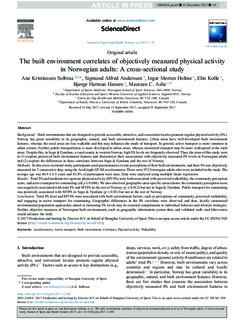| dc.description.abstract | Background: Built environments that are designed to provide accessible, attractive, and convenient locales promote regular physical activity (PA). Norway has great variability in its geographic, natural, and built environment features. Urban areas have well-developed built environment features, whereas the rural areas are less walkable and this may influence the mode of transport. In general, active transport is more common in urban centers. Further, public transportation is more developed in urban areas, whereas motorized transport may be more widespread in the rural areas. Despite this, in Sogn & Fjordane, a rural county in western Norway, high PA levels are frequently observed. Thus, the aims of this study were to (1) explore perceived built environment features and characterize their associations with objectively measured PA levels in Norwegian adults and (2) explore the differences in these correlates between Sogn & Fjordane and the rest of Norway.
Methods: In this cross-sectional study, participants used questionnaires to rate perceptions of their built environments, and their PA was objectively measured for 7 consecutive days using the ActiGraph GT1M accelerometer. There were 972 Norwegian adults who were included in the study. The average age was 46.9 ± 6.5 years and 43.8% of participants were men. Data were analyzed using multiple linear regression.
Results: Total PA and moderate-to-vigorous physical activity (MVPA) were both associated with perceived walkability, the community perception score, and active transport for commuting (all p ≤ 0.004). We also observed geographic-area-specific associations: the community perception score was negatively associated with total PA and MVPA in the rest of Norway (p ≤ 0.012) but not in Sogn & Fjordane. Public transport for commuting was positively associated with MVPA in Sogn & Fjordane (p = 0.03) but not in the rest of Norway.
Conclusion: Total PA level and MVPA were associated with built environment factors, such as perceptions of community, perceived walkability, and engaging in active transport for commuting. Geographic differences in the PA correlates were observed, and thus, locally customized environmental population approaches aimed at increasing PA levels may be essential complements to individual behavior and lifestyle strategies. Further, objective measures of Norwegian built environments, such as geographic information system data, and validated walk- and bike-scores would advance the field. | |
